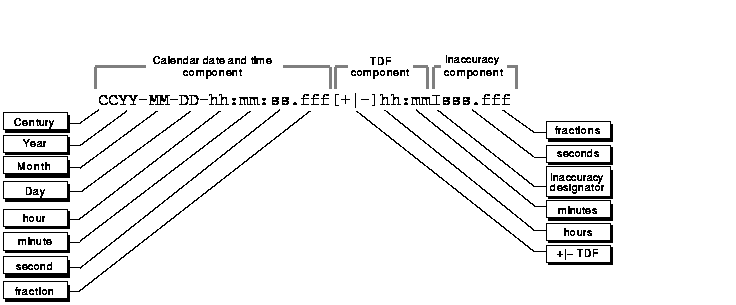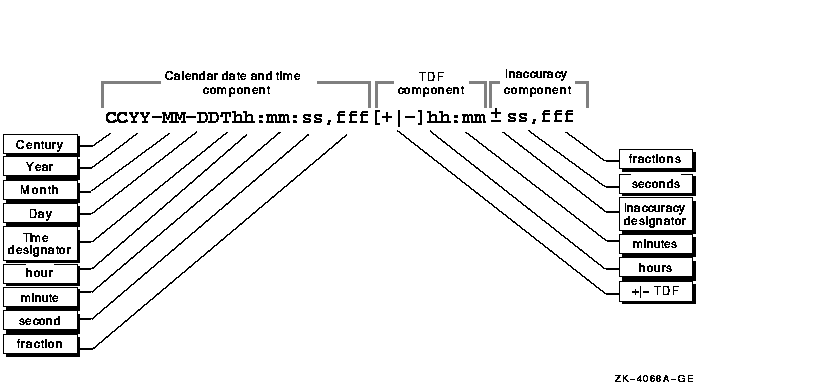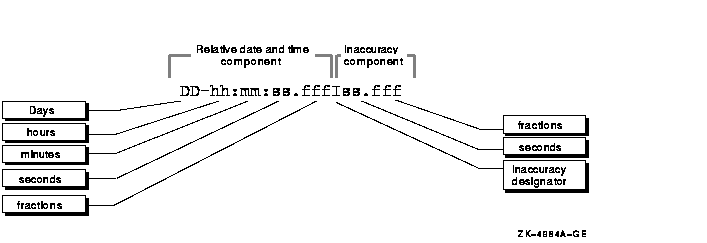OpenVMS Utility Routines Manual
FILE_SEARCH
This is a user-written routine that is used in place of the
TPU$FILE_SEARCH routine.
Format
FILE_SEARCH result-string ,flags ,filespec ,default-spec ,related-spec
RETURNS
| OpenVMS usage: |
cond_value |
| type: |
longword (unsigned) |
| access: |
write only |
| mechanism: |
by value |
Longword condition value. If an odd numeric value is returned, the next
call to the built-in procedure FILE_SEARCH automatically sets the
TPU$M_REPARSE bit in the flags longword. TPU$M_REPARSE is also set if
the result-string has a length of 0.
Arguments
result-string
| OpenVMS usage: |
char_string |
| type: |
character string |
| access: |
write only |
| mechanism: |
by descriptor |
Return value for the built-in procedure FILE_SEARCH. Your program
should fill in this descriptor with a dynamic string allocated by the
string routines such as the Run-Time Library routine LIB$SGET1_DD.
DECTPU frees this string when necessary.
The TPU$M_REPARSE bit is set in the flags longword if the
result-string has a length of zero. The bit is
intended to reset the file search when wildcard searches are performed.
flags
| OpenVMS usage: |
longword_unsigned |
| type: |
longword (unsigned) |
| access: |
read only |
| mechanism: |
by reference |
The following table shows the flags used for specifying the file
components:
| Flag1 |
Function |
|
TPU$M_NODE
|
Requests for the node component of the file specification.
|
|
TPU$M_DEV
|
Requests for the device component of the file specification.
|
|
TPU$M_DIR
|
Requests for the directory component of the file specification.
|
|
TPU$M_NAME
|
Requests for the name component of the file specification.
|
|
TPU$M_TYPE
|
Requests for the type component of the file specification.
|
|
TPU$M_VER
|
Requests for the version component of the file specification.
|
|
TPU$M_REPARSE
|
Reparses the file specification before processing. This is intended as
a way to restart the file search. This flag will automatically be set
by DECTPU if on a previous call to the FILE_SEARCH user routine the
result-string has a zero length or the routine returns
a odd (noneven) status.
|
|
TPU$M_HEAD
|
Requests for the NODE, DEVICE, and DIRECTORY components of the file
specification.
|
|
TPU$M_TAIL
|
Requests for the NAME, TYPE, and VERSION component of the file
specification.
|
1TPU$M... indicates a mask. There is a corresponding value
for each mask in the form TPU$V....
filespec
| OpenVMS usage: |
char_string |
| type: |
character string |
| access: |
read only |
| mechanism: |
by descriptor |
The object file specification.
default-spec
| OpenVMS usage: |
char_string |
| type: |
character string |
| access: |
read only |
| mechanism: |
by descriptor |
The default-spec argument contains the default file
specification.
The value 0 is passed if there is no default-spec.
related-spec
| OpenVMS usage: |
char_string |
| type: |
character string |
| access: |
read only |
| mechanism: |
by descriptor |
The related-spec argument contains the related file
specification.
The value 0 is passed if there is no related-spec.
Description
The FILE_SEARCH user routine allows an application to replace the
TPU$FILE_SEARCH routine with its own file-searching routine. The
calling program passes the address of the routine to the TPU$INITIALIZE
routine using the TPU$_FILE_SEARCH item code.
When the DECTPU built-in procedure FILE_SEARCH is called from TPU code,
DECTPU calls either the user-written FILE_SEARCH routine (if one was
passed to TPU$INITIALIZE) or the TPU$FILE_SEARCH routine. The return
value of the built-in procedure is the string returned in the
result-string argument.
To ensure proper operation of the user's ON_ERROR handlers, errors in
the user-written FILE_PARSE routine should be signaled using the
TPU$SIGNAL routine.
HANDLER
The user-written HANDLER routine performs condition handling.
Format
HANDLER signal_vector ,mechanism_vector
RETURNS
| OpenVMS usage: |
cond_value |
| type: |
longword (unsigned) |
| access: |
write only |
| mechanism: |
by value |
Longword condition value.
Arguments
signal_vector
| OpenVMS usage: |
arg_list |
| type: |
longword (unsigned) |
| access: |
modify |
| mechanism: |
by reference |
Signal vector. See the OpenVMS System Services Reference Manual for information about the signal
vector passed to a condition handler.
mechanism_vector
| OpenVMS usage: |
arg_list |
| type: |
longword (unsigned) |
| access: |
read only |
| mechanism: |
by reference |
Mechanism vector. See the OpenVMS System Services Reference Manual for information about the
mechanism vector passed to a condition handler.
Description
If you need more information about writing condition handlers and
programming concepts, refer to OpenVMS Programming Interfaces: Calling a System Routine.
Instead of writing your own condition handler, you can use the default
condition handler, TPU$HANDLER. If you want to write your own routine,
you must call TPU$HANDLER with the same parameters that your routine
received to handle DECTPU internal signals.
INITIALIZE
The user-written initialization callback routine is passed to
TPU$INITIALIZE as a bound procedure value and called to supply
information needed to initialize DECTPU.
Format
INITIALIZE [user_arg]
RETURNS
| OpenVMS usage: |
item_list |
| type: |
longword (unsigned) |
| access: |
read only |
| mechanism: |
by reference |
This routine returns the address of an item list.
Arguments
user_arg
| OpenVMS usage: |
user_arg |
| type: |
longword (unsigned) |
| access: |
read only |
| mechanism: |
by value |
User argument.
Description
The user-written initialization callback routine is passed to
TPU$INITIALIZE as a bound procedure value and called to supply
information needed to initialize DECTPU.
If the user_arg parameter was specified in the call to
TPU$INITIALIZE, the initialization callback routine is called with only
that parameter. If user_arg was not specified in the
call to TPU$INITIALIZE, the initialization callback routine is called
with no parameters.
The user_arg parameter is provided to allow an
application to pass information through TPU$INITIALIZE to the
user-written initialization routine. DECTPU does not interpret this
data in any way.
The user-written callback routine is expected to return the address of
an item list containing initialization parameters. Because the item
list is used outside the scope of the initialization callback routine,
it should be allocated in static memory.
The item list entries are discussed in the section about
TPU$INITIALIZE. . Most of the initialization parameters have a default
value; strings default to the null string, and flags default to false.
The only required initialization parameter is the address of a routine
for file I/O. If an entry for the file I/O routine address is not
present in the item list, TPU$INITIALIZE returns with a failure status.
USER
The user-written USER routine allows your program to take control
during a DECTPU editing session (for example, to leave the editor
temporarily and perform a calculation).
Format
USER integer ,stringin ,stringout
RETURNS
| OpenVMS usage: |
cond_value |
| type: |
longword (unsigned) |
| access: |
write only |
| mechanism: |
by value |
Longword condition value.
Arguments
integer
| OpenVMS usage: |
longword_unsigned |
| type: |
longword (unsigned) |
| access: |
read only |
| mechanism: |
by reference |
First parameter to the built-in procedure CALL_USER. This is an
input-only parameter and must not be modified.
stringin
| OpenVMS usage: |
char_string |
| type: |
character string |
| access: |
read only |
| mechanism: |
by descriptor |
Second parameter to the built-in procedure CALL_USER. This is an
input-only parameter and must not be modified.
stringout
| OpenVMS usage: |
char_string |
| type: |
character string |
| access: |
modify |
| mechanism: |
by descriptor |
Return value for the built-in procedure CALL_USER. Your program should
fill in this descriptor with a dynamic string allocated by the string
routines (such as LIB$SGET1_DD) provided by the Run-Time Library. The
DECTPU editor frees this string when necessary.
Description
This user-written routine is invoked by the DECTPU built-in procedure
CALL_USER. The built-in procedure CALL_USER passes three parameters to
this routine. These parameters are then passed to the appropriate part
of your application to be used as specified. (For example, they can be
used as operands in a calculation within a Fortran program.) Using the
string routines provided by the Run-Time Library, your application
fills in the stringout parameter in the call-user
routine, which returns the stringout value to the
built-in procedure CALL_USER.
The description of the built-in procedure CALL_USER in the
DEC Text Processing Utility Reference Manual shows an example of a BASIC program that is a call-user
routine.
See Section 8.5 for a description of how to create an executeable
image for the USER routine and how to call the routine from a C program
in the DECTPU environment.
Chapter 9
DECdts Portable Applications Programming Interface
You can use the DIGITAL Distributed Time Service (DECdts) programming
routines to obtain timestamps that are based on Coordinated Universal
Time (UTC). You can also use the DECdts routines to translate among
different timestamp formats and perform calculations on timestamps.
Applications can use the timestamps that DECdts supplies to determine
event sequencing, duration, and scheduling. Applications can call the
DECdts routines from DECdts server or clerk systems.
The DIGITAL Distributed Time Service routines are written in the C
programming language. You should be familiar with the basic DECdts
concepts before you attempt to use the applications programming
interface (API).
The DECdts API routines can perform the following basic functions:
- Retrieve timestamp information
- Convert between binary timestamps that use different time structures
- Convert between binary timestamps and ASCII representations
- Convert between UTC time and local time
- Convert the binary time values in the OpenVMS (Smithsonian-based)
format to or from UTC-based binary timestamps (OpenVMS systems only)
- Manipulate binary timestamps
- Compare two binary time values
- Calculate binary time values
- Obtain time zone information
DECdts can convert between several types of binary time structures that
are based on different calendars and time unit measurements. DECdts
uses UTC-based time structures and can convert other types of time
structures to its own presentation of UTC-based time.
The following sections describe DECdts time representations, DECdts
time structures, API header files, and API routines.
9.1 DECdts Time Representation
UTC is the international time standard that has largely replaced
Greenwich Mean Time (GMT). The standard is administered by the
International Time Bureau (BIH) and is widely used. DECdts uses opaque
binary timestamps that represent UTC for all of its internal processes.
You cannot read or disassemble a DECdts binary timestamp; the DECdts
API allows applications to convert or manipulate timestamps, but they
cannot be displayed. DECdts also translates the binary timestamps into
ASCII text strings, which can be displayed.
9.1.1 Absolute Time Representation
An absolute time is a point on a time scale. For
DECdts, absolute times reference the UTC time scale; absolute time
measurements are derived from system clocks or external time-providers.
When DECdts reads a system clock time, it records the time in an opaque
binary timestamp that also includes the inaccuracy and other
information. When you display an absolute time, DECdts converts the
time to ASCII text, as shown in the following display:
1996-11-21-13:30:25.785-04:00I000.082
|
DECdts displays all times in a format that complies with the
International Standards Organization (ISO) 8601 (1988) standard. Note
that the inaccuracy portion of the time is not defined in the ISO
standard (times that do not include an inaccuracy are accepted).
Figure 9-1 explains the ISO format that generated the previous
display.
Figure 9-1 Time Display Format

In Figure 9-1, the relative time preceded by the plus (+) or minus
(-) character indicates the hours and minutes that the calendar date
and time are offset from UTC. The presence of this time
differential factor (TDF) in the string also indicates that
the calendar date and time are the local time of the system, not UTC.
Local time is UTC minus the TDF. The Inaccuracy designator
I
indicates the beginning of the inaccuracy component associated with the
time.
Although DECdts displays all times in the previous format, variations
in the ISO format shown in Figure 9-2 are also accepted as input for
the ASCII conversion routines.
Figure 9-2 Time Display Format Variants

In Figure 9-2, the Time designator
T
separates the calendar date from the time, a comma separates seconds
from fractional seconds, and the plus or minus character indicates the
beginning of the inaccuracy component.
The following examples show some valid time formats.
The following represents July 4, 1776 17:01 GMT and an infinite
inaccuracy (default).
The following represents a local time of 12:01 (17:01 GMT) on July 4,
1776 with a TDF of -5 hours and an inaccuracy of 100 seconds.
1776-7-4-12:01:00-05:00I100
|
Both of the following represent 12:00 GMT in the current day, month,
and year with an infinite inaccuracy.
The following represents July 14, 1792 00:00 GMT with an infinite
inaccuracy.
9.1.2 Relative Time Representation
A relative time is a discrete time interval that is
usually added to or subtracted from another time. A TDF associated with
an absolute time is one example of a relative time. A relative time is
normally used as input for commands or system routines.
Figure 9-3 shows the full syntax for a relative time.
Figure 9-3 Relative Time Syntax

Notice that a relative time does not use the calendar date fields,
because these fields concern absolute time. A positive relative time is
unsigned; a negative relative time is preceded by a minus ( - ) sign. A
relative time is often subtracted from or added to another relative or
absolute time. The relative times that DECdts uses internally are
opaque binary timestamps. The DECdts API offers several routines that
can be used to calculate new times using relative binary timestamps.
The following example shows a relative time of 21 days, 8 hours, and 30
minutes, 25 seconds with an inaccuracy of 0.300 second.
The following example shows a negative relative time of 20.2 seconds
with an infinite inaccuracy (default).
The following example shows a relative time of 10 minutes, 15.1 seconds
with an inaccuracy of 4 seconds.
Representing Periods of Time
A given duration of a period of time can be represented by a data
element of variable length that uses the syntax shown in Figure 9-4.
Figure 9-4 Time Period Syntax

The data element contains the following parts:
- The designator
P
precedes the part that includes the calendar components, including the
following:
- The number of years followed by the designator
Y
- The number of months followed by the designator
M
- The number of weeks followed by the designator
W
- The number of days followed by the designator
D
- The designator
T
precedes the part that includes the time components, including the
following:
- The number of hours followed by the designator
H
- The number of minutes followed by the designator
M
- The number of seconds followed by the designator
S
- The designator
I
precedes the number of seconds of inaccuracy.
The following example represents a period of 1 year, 6 months, 15 days,
11 hours, 30 minutes, and 30 seconds and an infinite inaccuracy.
The following example represents a period of 3 weeks and an inaccuracy
of 4 seconds.
9.2 Time Structures
DECdts can convert between several types of binary time structures that
are based on different base dates and time unit measurements. DECdts
uses UTC-based time structures and can convert other types of time
structures to its own presentation of UTC-based time. The DECdts API
routines are used to perform these conversions for applications on your
system.
Table 9-1 lists the absolute time structures that the DECdts API
uses to modify binary times for applications.
Table 9-1 Absolute Time Structures
| Structure |
Time Units |
Base Date |
Approximate Range |
|
utc
|
100-nanosecond
|
15 October 1582
|
A.D. 1 to A.D. 30,000
|
|
tm
|
second
|
1 January 1900
|
A.D. 1 to A.D. 30,000
|
|
timespec
|
nanosecond
|
1 January 1970
|
A.D. 1970 to A.D. 2106
|
Table 9-2 lists the relative time structures that the DECdts API
uses to modify binary times for applications.
The remainder of this section explains the DECdts time structures in
detail.
|



